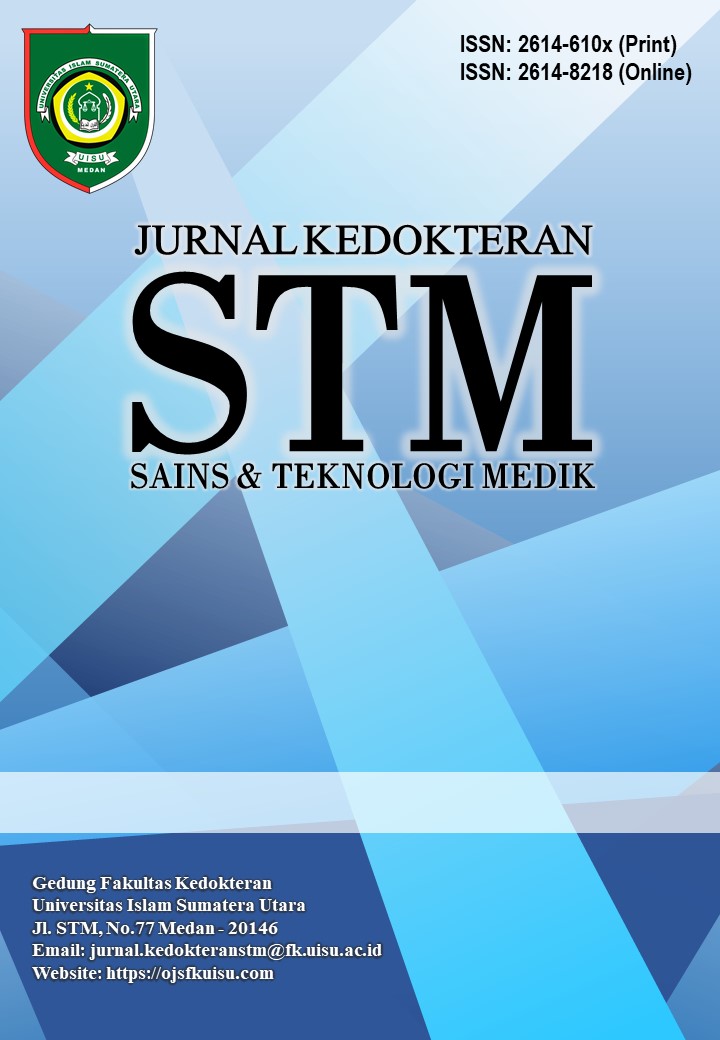PEMANFAATAN NAILFOLD VIDEOCAPILLAROSCOPIC DALAM MENGEKSPLORASI FAKTOR RISIKO, PREDIKTOR DAN PREVENTIF GANGGUAN MIKROSIRKULASI KARDIOVASKULAR
UTILIZATION OF NAILFOLD VIDEOCAPILLAROSCOPIC TO EXPLORING RISK FACTORS, PREDICTORS AND PREVENTION OF CARDIOVASCULAR MICROCIRCULATORY DISORDERS
Abstract
Microcirculation disorders are the focus of attention in cardiovascular disease research as they lead to serious cardiovascular complications. Nailfold videocapillaroscopy (NVC) is a non-invasive method that has great potential in exploring risk factors, clinical predictors and developing preventive measures for microcirculatory disorders in cardiovascular disease. This study was based on PRISMA guidelines, then adjusted with appropriate inclusion and exclusion criteria and the PICO framework. Risk of bias assessment using the Joanna Briggs Institute (JBI). There were 14 inclusion studies including cohort, case-control, cross-sectional, comparative and multicentre studies. The results found that the utilisation of NVC is proven to be used in the exploration of risk factors, predictors and preventive measures of microcirculatory disorders of several cardiovascular diseases namely primary, secondary and pulmonary hypertension with vasculitis. Risk factors include endothelial damage, arterial stiffness, and so on. Future predictors can be done in patients with microvascular abnormalities suspected of systemic sclerosis, Raynaud's symptom and hormonal disorders. Preventive measures that can be carried out further supporting examinations in confirming disease disorders and complications. With the utilisation of NVC, the public can utilise this technology as an early detection tool to prevent more serious cardiovascular complications.
Abstrak
Gangguan mikrosirkulasi menjadi fokus perhatian dalam penelitian penyakit kardiovaskular karena mengakibatkan komplikasi serius bagi kardiovaskular. Nailfold videocapillaroscopy (NVC) merupakan metode non-invasif yang memiliki potensi besar sebagai dalam mengeksplorasi faktor risiko, prediktor klinis dan menyusun langkah prevetif terhadap gangguan mikrosirkulasi penyakit kardiovaskular. Penelitian ini didasarkan pada pedoman PRISMA, kemudian disesuaikan dengan kriteria inklusi dan eksklusi yang sesuai dan kerangka kerja PICO. Penilaian risiko bias menggunakan Joanna Briggs Institute (JBI). Didapatkan 14 studi inklusi termasuk studi cohort, case-control, cross-sectional, comparative dan multicenter study. Hasil penelitian menemukan bahwa pemanfaatan NVC terbukti dapat digunakan dalam eksplorasi faktor risiko, prediktor dan langkah preventif gangguan mikrosirkulasi dari beberapa penyakit kardiovaskular yakni hipertensi primer, sekunder dan pulmonal disertai vaskulitis. Faktor risiko yang didapatkan mulai dari kerusakan endotel, kekuan arteri, dan sebagainya. Predikor kedepannya dapat dilakukan pada pasien abnormalitas pada mikrovaskular yang dicurigai mengalami sistemik sklerosis, gejala raynaud dan gangguan hormon. Langkah preventif yang dapat dilakukan pemeriksaan penunjang lanjutan dalam mengkonfirmasi gangguan penyakit dan komplikasi. Dengan demikian pemanfaatan NVC, masyarakat dapat memanfaatkan teknologi ini sebagai alat deteksi dini untuk mencegah komplikasi kardiovaskular yang lebih serius.
References
Tibiriçá E, Lorenzo AD, Oliveira GMM. Microcirculation and Cardiovascular Diseases. Arq. Bras. Cardiol. 2018;111(2):120-1
Sidik N, Morrow A, Berry C. Human Microcirculation in Ischemic Heart Disease. Arterioscler Thromb Vasc Biol. 2020;40(1):11-13.
Rehan R, Yong A, Ng M, Weaver J, Puranik R. Coronary microvascular dysfunction: A review of recent progress and clinical implications. Front Cardiovasc Med. 2023;10:1111721.
Katunaric B, Cohen KE, Beyer AM, Gutterman DD, Freed JK. Sweat the small stuff: The human microvasculature and heart disease. Microcirculation. 2021;28(3):e12658.
Yang Z, Liu Y, Li Z, et al. Coronary microvascular dysfunction and cardiovascular disease: Pathogenesis, associations and treatment strategies. Biomed Pharmacother. 2023;164:115011.
Torrens Cid LA, Soleto K CY, Montoro-Álvarez M, Sáenz Tenorio C, Silva-Riveiro A, López-Cerón A, Anzola Alfaro AM, Caballero Motta LR, Serrano Benavente B, Martínez-Barrio J, Ovalles-Bonilla JG, González Fernández CM, Monteagudo Sáez I, Nieto-González JC. Clinical impact of nailfold capillaroscopy in daily clinical practice. Reumatol Clin (Engl Ed). 2021 May;17(5):258-262. English, Spanish.
Mendelson AA, Erickson D, Villar R. The role of the microcirculation and integrative cardiovascular physiology in the pathogenesis of ICU-acquired weakness. Front Physiol. 2023;14:1170429.
Pries AR, Reglin B. Coronary microcirculatory pathophysiology: can we afford it to remain a black box?. Eur Heart J. 2017;38(7):478-488.
Rezende PC, Ribas FF, Serrano CV Jr, Hueb W. Clinical significance of chronic myocardial ischemia in coronary artery disease patients. J Thorac Dis. 2019;11(3):1005-1015.
Mrowietz C, Sievers H, Pindur G, Hiebl B, Jung F. Cutaneous microcirculation in patients with peripheral arterial occlusive disease: Comparison of capillary blood circulation in the nail fold of finger and toe. Hiebl B, Krüger-Genge A, Jung F, editors. Clinical Hemorheology and Microcirculation. 2020 Oct 30;76(2):279–85.
Etehad Tavakol M, Fatemi A, Karbalaie A, Emrani Z, Erlandsson BE. Nailfold Capillaroscopy in Rheumatic Diseases: Which Parameters Should Be Evaluated? BioMed Research International. 2015;2015:1–17.
Bardehle F, Sies K, Enk A, Rosenberger A, Fink C, Haenssle H. Nailfold videocapillaroscopy identifies microvascular pathologies in psoriasis vulgaris: Results of a prospective controlled study. JDDG - J Ger Soc Dermatology. 2021;19(12):1736–44.
Chianese M, Screm G, Confalonieri P, Salton F, Trotta L, Da Re B, et al. Nailfold Video-Capillaroscopy in Sarcoidosis: New Perspectives and Challenges. Tomogr (Ann Arbor, Mich). 2024;10(10):1547–63.
De Angelis R, Riccieri V, Cipolletta E, et al. Significant nailfold capillary loss and late capillaroscopic pattern are associated with pulmonary arterial hypertension in systemic sclerosis. Rheumatology (Oxford). 2024;63(6):1616-1623.
Wang L, Chen H, Ding Z, Ma L, Sun Y, Jiang L. Associations of microcirculation damage on nailfold capillaroscopy with supra-aortic severe ischemic events in patients with Takayasu arteritis. Clin Rheumatol. 2023;42(6):1625-1634.
Miziołek B, Pieczyrak R, Polak K, et al. Role of short courses on nailfold capillaroscopy in obtaining abilities for the identification of microvasculopathy in patients with Raynaud's phenomenon. Skin Res Technol. 2023;29(1):e13223.
Niklas K, Niklas A, Mularek-Kubzdela T, Puszczewicz M, Samborski W. Relationship between changes observed in nailfold capillaroscopy and serological profile, lung fibrosis, and elevated risk of pulmonary hypertension in patients with systemic sclerosis and mixed connective tissue disease. Postepy Dermatol Alergol. 2022;39(5):880-886.
Keret S, Mazzawi J, Slobodin G, et al. Nailfold video capillaroscopy as a useful diagnostic tool in systemic vasculitis. Microvasc Res. 2022;143:104406.
Arvanitaki A, Giannakoulas G, Triantafyllidou E, et al. Peripheral microangiopathy in Eisenmenger syndrome: A nailfold video capillaroscopy study. Int J Cardiol. 2021;336:54-59.
Pagkopoulou E, Soulaidopoulos S, Triantafyllidou E, et al. Peripheral microcirculatory abnormalities are associated with cardiovascular risk in systemic sclerosis: a nailfold video capillaroscopy study. Clin Rheumatol. 2021;40(12):4957-4968.
Fathi, H.M., Fawzy, M.W., Aboul-Eyon, I.I., Eldesouky, A.H., & Eesa, N.N. Value of nail fold video capillaroscopy and carotid intima media thickness in assessment of micro and macro-vascular disease in systemic sclerosis patients. The Egyptian Rheumatologist. 2021; 43, 275-280.
Arvanitaki A, Giannakoulas G, Triantafyllidou E, et al. Peripheral microangiopathy in precapillary pulmonary hypertension: a nailfold video capillaroscopy prospective study. Respir Res. 2021;22(1):27.
Concistrè A, Petramala L, Bonvicini M, et al. Comparisons of skin microvascular changes in patients with primary aldosteronism and essential hypertension. Hypertens Res. 2020;43(11):1222-1230.
Gorski, S., Bartnicka, M., Citko, A., Żelazowska-Rutkowska, B., Jablonski, K., & Gorska, A. Microangiopathy in Naifold Videocapillaroscopy and Its Relations to sE- Selectin, Endothelin-1, and hsCRP as Putative Endothelium Dysfunction Markers among Adolescents with Raynaud’s Phenomenon. Journal of Clinical Medicine. 2019; 8(5), 567.
Corrado A, Correale M, Mansueto N, et al. Nailfold capillaroscopic changes in patients with idiopathic pulmonary arterial hypertension and systemic sclerosis-related pulmonary arterial hypertension. Microvasc Res. 2017;114:46-51.
Voilliot D, Magne J, Dulgheru R, et al. Prediction of new onset of resting pulmonary arterial hypertension in systemic sclerosis. Arch Cardiovasc Dis. 2016;109(4):268-277.
Rennie, Darryn. Naifold Dermatoscopy in General Practice. Australian Family Physician. 2015; 44 (11).
Pagkopoulou E, Soulaidopoulos S, Triantafyllidou E, et al. Peripheral microcirculatory abnormalities are associated with cardiovascular risk in systemic sclerosis: a nailfold video capillaroscopy study. Clin Rheumatol. 2021;40(12):4957-4968.
Copyright (c) 2025 Bima Diokta Alparisi, Nindy Putri Amalia, Samira Amanda, Irwan, Haryadi

This work is licensed under a Creative Commons Attribution-ShareAlike 4.0 International License.



